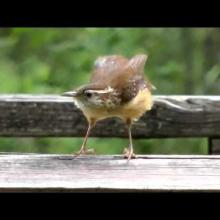

Join BirdNote tomorrow, November 30th!
Illustrator David Sibley and actor H. Jon Benjamin will face off in the bird illustration battle of the century during BirdNote's Year-end Celebration and Auction!
When a Carolina Wren like this one sings, something remarkable happens. These birds can sing so loudly that you almost have to shout to be heard over their songs!
How can a bird like a Carolina Wren – at just 5½ inches long and weighing only as much as four nickels – produce so much sound? The answer lies in the songbird’s vocal anatomy.
BirdNote®
Voices and Vocabularies - How Birds Sing So Loudly
Written by Bob Sundstrom
This is BirdNote.
[Carolina Wren song]
When a Carolina Wren tips back its head and sings, something remarkable happens. A Carolina Wren can sing so loudly that you almost have to shout to be heard over its song. [Carolina Wren song]
Wrens aren’t the only small birds with big voices, but they are the best known for this ability. How can a bird like a Carolina Wren, all of 5½ inches long and weighing only as much as four nickels, produce so much sound? [Carolina Wren song]
The answer lies in the songbird’s vocal anatomy. Unlike the human voice, which comes from the larynx way up at the top of the windpipe, a bird’s song comes from deep within its body. Birds produce song in a structure called the syrinx, located at the bottom of the windpipe where the bronchial tubes diverge to the lungs. The syrinx is surrounded by an air sac, and the combination works like a resonating chamber to maintain or amplify sound. [Carolina Wren song]
Evolution has given birds a far more elaborate sound mechanism than it’s given humans. Where we wound up with a flute, songbirds got bagpipes. [Carolina Wren song]
For BirdNote, I’m Michael Stein.
Support for BirdNote is provided by Jim and Birte Falconer from Seattle, Washington, and generous listeners around the world.
###
Bird sounds provided by The Macaulay Library of Natural Sounds at the Cornell Lab of Ornithology, Ithaca, New York. Carolina Wren song [128927] recorded by Gerrit Vyn.
BirdNote's theme music was composed and played by Nancy Rumbel and John Kessler.
Producer: John Kessler
Executive Producer: Chris Peterson
© 2015 Tune In to Nature.org April 2015 / February 2023 Narrator: Michael Stein
ID# sound-17-2013-04-11sound-17







